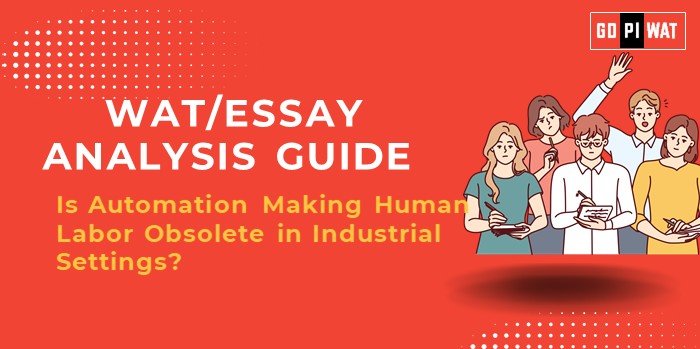📋 Written Ability Test (WAT)/Essay Analysis Guide: Is Automation Making Human Labor Obsolete in Industrial Settings?
🌐 Understanding the Topic’s Importance
Automation is a transformative force in industrial settings, influencing global production and economic models. For B-schools, this topic ties to strategic management, human resources, and innovation themes.
📝 Effective Planning and Writing
- ⏱️ Time Allocation:
- Planning: 5 minutes
- Writing: 20 minutes
- Reviewing: 5 minutes
- 📌 Preparation Tips:
- Collect key statistics on automation trends, stakeholder roles, and successful case studies.
📖 Introduction Techniques for Essays
🎭 Contrast Approach:
“While automation enhances efficiency, it disrupts traditional employment structures, raising critical socio-economic questions.”
🔧 Solution-Based Introduction:
“Automation, if paired with workforce reskilling, can lead to a sustainable industrial future.”
📜 Historical Context:
“From mechanization to intelligent robotics, industrial automation has evolved, redefining the role of human labor.”
📚 Structuring the Essay Body
🏆 Achievements:
- Highlight productivity gains, cost efficiencies, and quality improvements.
- Example: “Automation has cut production times by 70% in high-tech industries like electronics.”
⚠️ Challenges with Comparative Analysis:
- Discuss workforce displacement and economic implications.
- Example: “China’s automation wave has outpaced job retraining efforts, widening economic gaps.”
🔮 Future Outlook:
- Propose a sustainable model combining automation with human roles.
- Example: “Investments in upskilling can create hybrid roles, ensuring inclusivity in industrial progress.”
📌 Concluding Effectively
⚖️ Balanced Perspective:
“Automation is inevitable, but its success depends on addressing labor displacement through inclusive policies.”
🌍 Global Comparison:
“Like Germany’s Industry 4.0 approach, balancing technology with social safeguards can optimize automation’s impact.”
🔍 Analyzing Successes and Shortcomings
- ✅ Key Achievements: Operational efficiency, reduced costs, and innovation.
- ⚠️ Ongoing Challenges: Job losses, skill gaps, and economic inequality.
- 🌍 Global Context: Success stories like Estonia’s digital integration.
💡 Recommendations for Sustainable Progress
- Workforce reskilling programs.
- Policies for equitable technology distribution.
- Focus on human-machine collaboration.
📄 Sample Short Essays
⚖️ Balanced Perspective:
“Automation redefines labor, blending technology and human ingenuity. Its future depends on equitable integration.”
🔧 Solution-Oriented:
“By coupling automation with workforce training, industries can achieve sustainable growth.”
🌍 Global Comparison:
“Automation’s success in Germany highlights the value of strategic planning and worker inclusion.”
🎓 Insights for B-School Students
These comprehensive guides prepare you for engaging discussions and compelling essays on automation’s impact in industrial settings.


